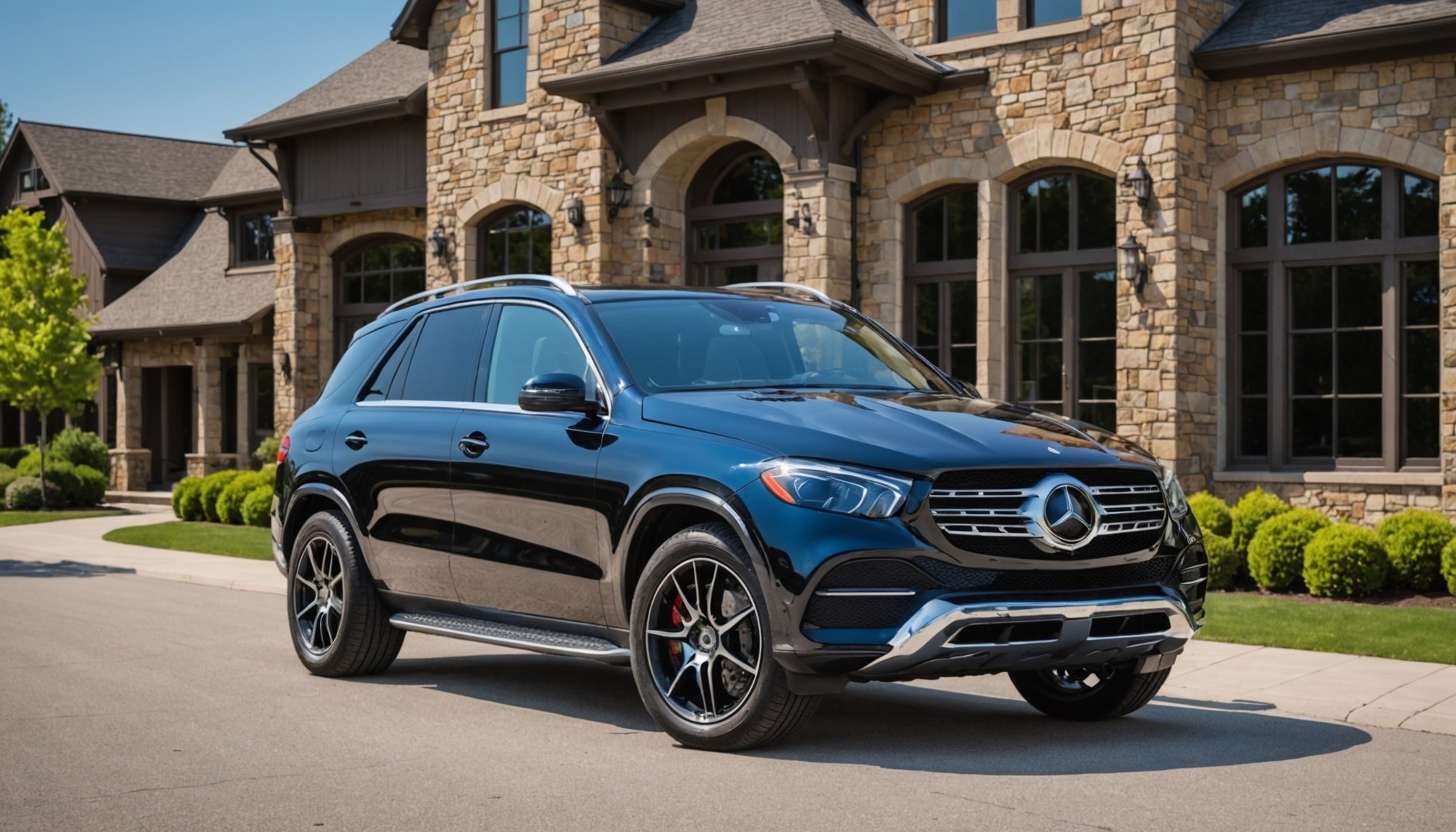Understanding Heat-Resistant Window Film
Heat-resistant window film provides numerous benefits for vehicle owners. Its primary function is to reduce heat gain from sunlight, making car interiors more comfortable. It also protects against harmful UV rays, which can fade upholstery and damage skin over time.
There are diverse types of window films available, each with unique features. For instance, ceramic films excel in blocking UV rays and reducing glare without compromising visibility. Metalized films, on the other hand, are known for their durability and superior heat rejection capabilities. Dyed films are often chosen for aesthetic reasons and affordability, though they may not be as effective at heat reduction as other types.
In parallel : Revamp Your Land Rover Discovery: Ultimate Suspension Upgrade Guide for Exciting Off-Road Adventures
Selecting the right film for a Mercedes-Benz GLE involves understanding the specific needs and preferences of the vehicle owner. The luxurious interior of a GLE can greatly benefit from a film that offers both high performance and a sleek appearance. It’s crucial to consider the balance between UV protection, heat reduction, and durability when choosing the best product for your vehicle. Making an informed decision will enhance comfort while protecting the car’s interior meticulously.
Tools Required for Installation
Installing window film effectively requires precise tools and quality equipment. The essential tools for film application include a squeegee, utility knife, spray bottle, lint-free cloth, and heat gun. A quality squeegee ensures a smooth surface free of air bubbles, which is crucial for a seamless installation. A sharp utility knife is needed for precise trimming, while a spray bottle provides a mixture of soap and water to assist in positioning the film. Lint-free cloths are vital to cleaning the glass surface before application, ensuring no dust particles remain. Lastly, a heat gun aids in shrinking the film to achieve a snug fit, especially along curved surfaces.
Topic to read : Revving Towards Sustainability: How Environmental Regulations are Transforming the Automotive Industry
Quality vs. Price
When selecting window film installation tools, the balance between quality and price significantly impacts the installation results. Investing in high-quality tools can prevent frustration and reduce errors, leading to a more professional finish.
Recommended Brands or Products
Notable brands, such as 3M and Olfa, provide exceptional utility knives and squeegees that are favoured by professionals. These window film installation tools are designed for precision and durability, ensuring they withstand frequent use and provide consistent performance, ultimately contributing to a flawless installation.
Step-by-Step Installation Guide
Installing window film requires careful preparation and methodical execution to achieve optimal results.
Preparation Steps
Begin by preparing the windows through thorough cleaning. Use a lint-free cloth and a mix of water and a mild detergent. This ensures no dust or debris interferes with the film adhesion. Dry the surface completely and inspect for any remaining imperfections to address them before proceeding with the installation.
Application Techniques
When applying window film, start by measuring carefully and cutting the film slightly larger than the window size. Use the utility knife for precision. Apply the soapy water mix liberally with a spray bottle. Position the film on the window, ensuring it’s aligned precisely. Use a squeegee to smooth out bubbles, working from the center toward the edges.
Finalizing the Installation
Trim excess film with a sharp utility knife for a clean edge, then use a heat gun carefully to shrink and secure the film, paying special attention to curved surfaces. Ensure the film is tightly adhered by giving it a final pass with the squeegee, focusing on edges. Proper adherence will prevent common issues like bubbling and improve visibility.
Expert Tips for Optimal Results
When installing window film, achieving the best adhesion and appearance involves following some expert installation tips. Firstly, ensure the environment is dust-free before beginning, as dust particles can lead to bubbles. Professionals stress the importance of using a high-quality squeegee to eliminate air pockets thoroughly.
Common mistakes include cutting corners too sharply or using a dull utility knife, which can cause jagged edges. Aligning the film correctly is vital; small misalignments may expand over the application, ultimately affecting the aesthetic and functional outcome.
Allow adequate curing time for the film to adhere properly. Recommendations often suggest avoiding raising and lowering the windows for at least one week post-installation. This patience ensures the adhesive bonds completely and reduces the risk of peeling or slippage.
During the curing period, maintain the car in a shaded area. Avoiding direct sunlight helps regulate temperature, preventing premature deformation of the film.
In summary, by avoiding common errors and understanding recommended conditions, one can elevate the quality and durability of their window film application, resulting in professional-level finishes that boast both aesthetic appeal and enhanced performance.
Troubleshooting Common Issues
Troubleshooting window film installations can be crucial to maintaining the aesthetics and longevity of your application. Common problems often arise, such as bubbling or peeling, which can detract from the visual appeal and functionality of the film.
Bubbling typically occurs when the adhesive does not bond properly to the window surface. This issue can often be resolved by carefully puncturing the bubble with a small, sharp pin and using a squeegee to smooth it out, ensuring the trapped air escapes. For peeling edges, reinforce the affected areas with a heat gun, applying gentle pressure to re-secure the film.
In some cases, improper installation may lead to scratch marks or cracks in the film. To address scratches, consider using a patch kit specifically designed for window films, following the instructions diligently. Persistent errors, however, might require professional intervention. Seeking expert help is advisable if the film appears beyond basic repair, especially if structural or large-scale damage is evident.
By addressing these common installation problems proactively, you can maintain the integrity and performance of your window film, ensuring it provides the intended benefits without distraction.
Safety Precautions and Maintenance
Adhering to safety precautions and practising proper maintenance are integral to the success of window film installation. When applying window film, it is crucial for installers to wear protective gloves and eyewear. This prevents accidental cuts and protects eyes from potential chemical exposure. Additionally, ensure the workplace is well-ventilated to avoid inhaling any fumes from adhesives.
To maximise the longevity of heat-resistant window film, post-installation care plays a significant role. Use a soft, non-abrasive cloth dampened with a mild cleaning solution to gently clean the film. Avoid ammonia-based products, which can degrade the film over time. Inspect the film periodically for signs of wear or damage, such as scratches or edges peeling away.
Regular inspections can help identify potential issues early, allowing for prompt addressing before they escalate. For long-term durability, reposition your vehicle out of direct sunlight when possible, as this helps regulate temperature and prevents undue stress on the film.
By implementing these safety and maintenance routines, the effectiveness and appearance of your window film can be preserved, resulting in ongoing benefits like improved vehicle comfort and interior protection.
Before-and-After Visuals
When it comes to the impact of window film, the transformation can be visually striking and functionally beneficial. Imagine stepping into a Mercedes-Benz GLE both before and after applying the window film. Initially, the car might feel uncomfortably warm with sunlight glaring through the windows. After installing heat-resistant window film, the interior climate becomes noticeably cooler and more comfortable, providing immediate relief on sunny days.
Witnessing the before and after transformation, one can appreciate the visual enhancements: a sleeker, more sophisticated appearance, complemented by improved privacy. The reduction in glare allows for a clearer view of exterior environments, enhancing both safety and aesthetics.
Testimonials from GLE owners commonly highlight these improvements. Many report not only appreciating cooler interiors but also noting reduced fading of upholstery and increased UV protection. These enhancements contribute significantly to preserving the luxury finish of their vehicles.
Additionally, the balance of performance with elegant design ensures that these changes meld seamlessly with the vehicle’s aesthetic. Essentially, this investment not only amplifies comfort but also bolsters the vehicle’s appeal and longevity. Thus, the transition is as impactful in function as it is in form.



